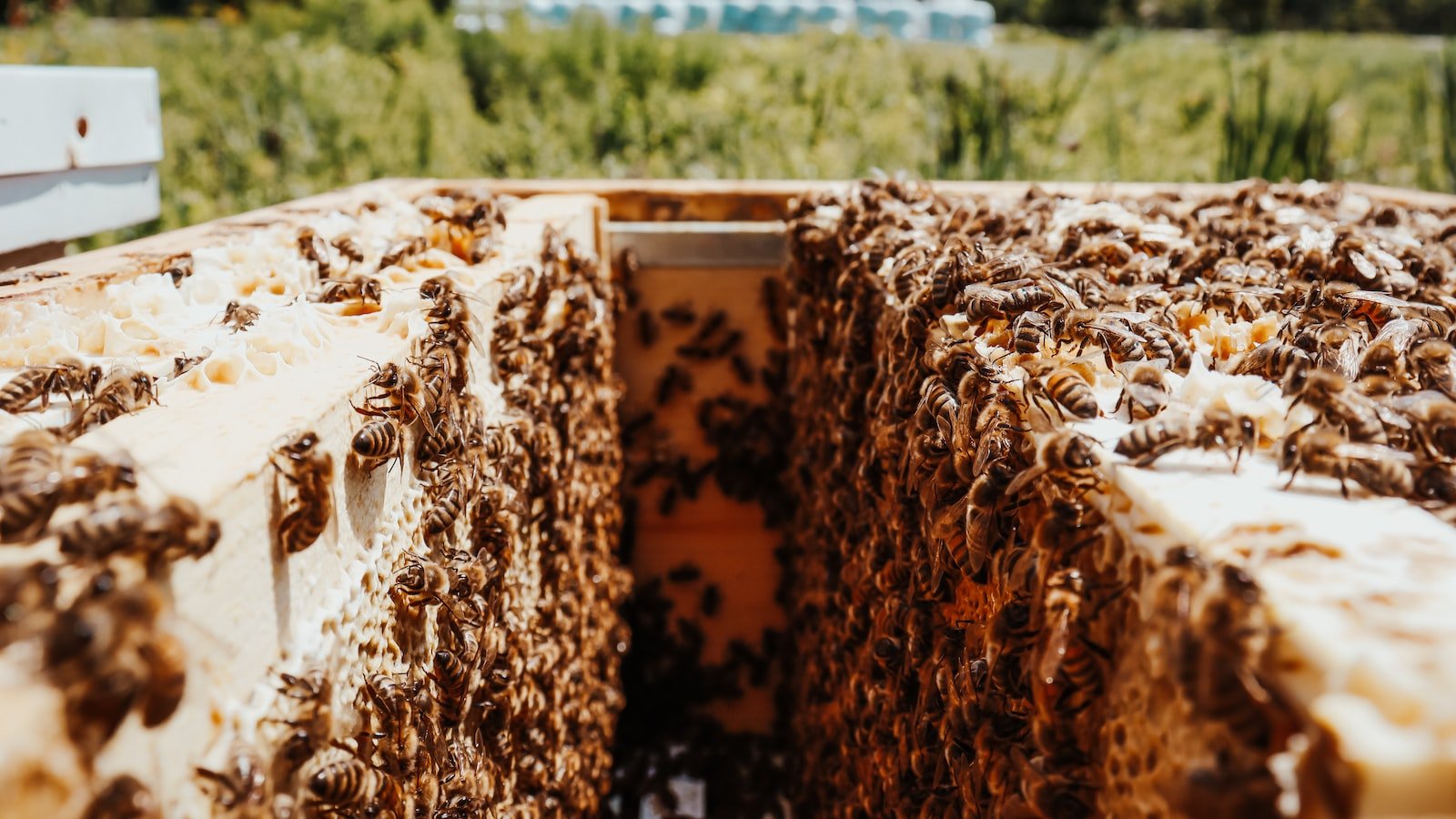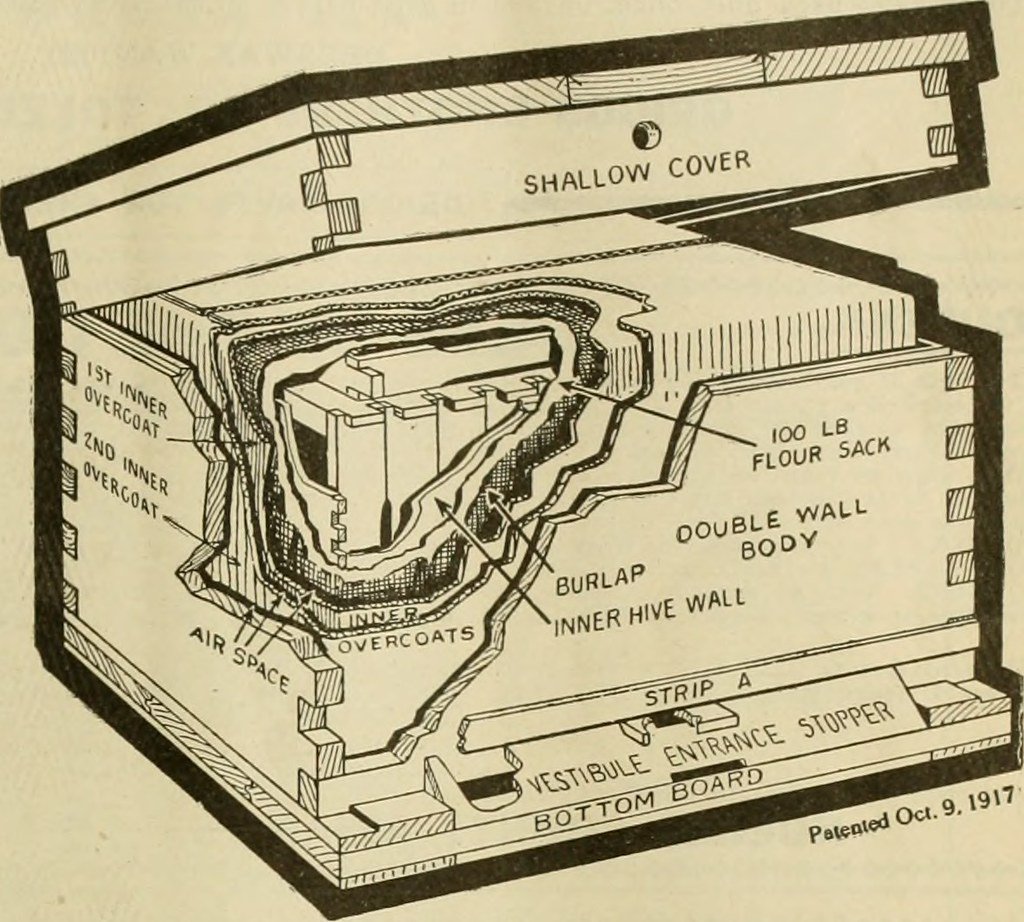As the chilly winds sweep across the frigid landscapes, honey bees brace themselves for a season of extraordinary challenges. Winter survival becomes a formidable task, one that hinges upon the delicate equilibrium within the hive. While bees possess remarkable adaptability, their survival is intricately tied to an often-overlooked component – hive insulation. Beneath the unassuming exterior of a buzzing hive lies a multitude of secrets, insulation being one of the most important. In this article, we embark on a journey to explore the vital role played by hive insulation in safeguarding these industrious creatures during the frosty winter months. Delving into the intricacies of thermal regulation, resource utilization, and communal resilience, we aim to uncover the hidden world that safeguards the survival of the hive in a winter wonderland. Join us as we delve into the depths of the beehive, unraveling the mysteries that lie within its well-insulated walls, and gaining a newfound appreciation for the remarkable tenacity of these miniature architects of nature.
Table of Contents
- The Role of Hive Insulation: Ensuring Winter Survival
- Exploring the Benefits of Hive Insulation for Bee Colonies
- Understanding How Hive Insulation Impacts Bee Health and Winter Survival
- Key Considerations for Proper Hive Insulation Installation
- Making Informed Choices: Selecting the Right Insulation Material for Bee Hives
- Q&A
- Future Outlook

The Role of Hive Insulation: Ensuring Winter Survival
When it comes to the survival of bee colonies during the harsh winter months, hive insulation plays a critical role. Insulating hives not only provides protection against freezing temperatures, but it also helps maintain the necessary temperature and humidity levels for the bees to survive.
Why is hive insulation important?
1. Regulating Temperature: During winter, honey bees cluster together to generate heat and keep the hive warm. However, without proper insulation, heat can easily escape, leaving the bees vulnerable to extreme cold. Insulation helps to maintain a stable temperature within the hive, preventing bees from freezing to death.
2. Preventing Moisture Build-up: In addition to cold temperatures, moisture can also pose a threat to bee colonies during winter. Insulation acts as a barrier, preventing condensation inside the hive, which can lead to dampness and mold. A dry hive is crucial for the bees’ overall health and survival.
3. Conserving Energy: By providing insulation, beekeepers can help reduce the amount of energy bees need to expend to keep the hive warm. This allows the bees to conserve energy and focus on other essential tasks during the winter, such as protecting the queen and maintaining food stores.
Types of hive insulation:
1. Wood Shavings: A commonly used insulation material is wood shavings or sawdust. It is affordable, readily available, and provides excellent insulation properties. Beekeepers can layer the hive’s walls and cover with wood shavings to create a cozy environment for the bees.
2. Straw or Hay: Another effective option is to use straw or hay as insulation. These natural materials act as excellent insulators, trapping heat and maintaining a comfortable temperature for the colony. It is important to ensure the straw or hay is dry to avoid mold growth.
3. Insulating Wraps: Insulating wraps are specially designed covers that encase the entire hive, providing an extra layer of insulation. Made from materials like foam or reflective fabric, these wraps help retain heat and keep the hive protected from cold winds.
Proper hive insulation is key to safeguarding bee populations during winter and ensuring their survival until spring arrives. By implementing effective insulation methods, beekeepers can contribute to the well-being of their colonies and support the impressive work of these essential pollinators.

Exploring the Benefits of Hive Insulation for Bee Colonies
Insulating bee hives may seem like an unconventional practice, but it has shown significant benefits for bee colonies. The insulation helps to create a conducive environment for the bees, ensuring their optimal health and productivity.
One of the key advantages of hive insulation is the regulation of temperature. Like any other living beings, bees are sensitive to extreme temperatures. Insulation helps maintain a stable temperature within the hive, preventing overheating in the summer and providing warmth during the cold winter months. This temperature control not only keeps the bees comfortable but also boosts their metabolic functions, allowing them to focus more on important tasks like honey production and brood rearing.
Moreover, insulation assists in preserving the food stores within the hive. Bees store honey as their main source of nutrition, especially during winters when foraging is limited. However, fluctuating temperatures can cause the honey to solidify or ferment, making it unusable. By insulating the hive, beekeepers can ensure a steady temperature that safeguards the stored honey, keeping it in its optimal state for longer periods. This ultimately benefits the colony’s survival and productivity.
With hive insulation, bee colonies can experience reduced stress levels. Insulated hives reduce the noise from external factors, such as rain and wind, creating a quieter and more peaceful environment for the bees. This tranquility contributes to decreased stress on the colony, allowing the bees to focus on their essential tasks without distraction. Additionally, insulation acts as a barrier against pests and predators, providing an extra line of defense for the bees and further reducing their stress levels.
- Regulates hive temperature, promoting optimal bee health and productivity.
- Preserves stored honey by maintaining a steady temperature, preventing spoilage.
- Decreases stress levels in the colony, providing a peaceful environment for the bees.
- Acts as a barrier against pests and predators, enhancing bee colony protection.

Understanding How Hive Insulation Impacts Bee Health and Winter Survival
Beekeepers understand the critical role that hive insulation plays in ensuring the health and survival of their beloved bees during the harsh winter months. Insulation is like a warm blanket for the hive, protecting the delicate bees and their precious honey stores from the frigid temperatures outside.
So, how exactly does hive insulation impact bee health and winter survival? Let’s take a closer look:
The Benefits of Adequate Hive Insulation:
- Temperature Regulation: Just like humans, bees need to maintain a constant temperature within their hive. Proper insulation helps retain heat generated by the bees’ metabolic activity, ensuring that the hive remains warm enough for their survival.
- Prevention of Moisture Build-up: A well-insulated hive also aids in controlling moisture levels. Excessive condensation can be detrimental to the bees’ health, potentially leading to mold growth, a weakened immune system, and increased susceptibility to diseases.
- Honey Conservation: Insulation plays a crucial role in minimizing the consumption of honey reserves. By reducing heat loss, bees require less energy to maintain warmth, thereby conserving their limited honey stores for nourishment.
Factors to Consider for Effective Insulation:
- Material Selection: The choice of insulation material is vital. Beekeepers often utilize materials like shredded paper, straw, or specialized hive insulation boards. Each material has its pros and cons, including cost, insulation efficiency, and ease of installation.
- Insulation Thickness: The appropriate insulation thickness ensures that the hive is well protected without hindering ventilation. It is essential to strike the right balance to prevent overheating or excessive cooling.
- Hive Location: The geographical location of the hive determines the severity of winter conditions. Beekeepers in colder regions may need to prioritize thicker insulation and consider wrapping the hive to provide additional protection.
Now, armed with a better understanding of the impact of hive insulation on bee health and winter survival, beekeepers can make informed decisions to create a cozy haven for their industrious pollinators.
Key Considerations for Proper Hive Insulation Installation
When it comes to setting up a beehive, proper insulation installation is crucial for the well-being and productivity of your buzzing colony. Here are some key considerations to keep in mind:
- Choose the right materials: Using high-quality insulation materials is essential to protect your bees from extreme temperature fluctuations. Opt for materials like polystyrene or wood wool that offer excellent insulation properties, while being non-toxic for your colony.
- Prioritize proper ventilation: While insulation is necessary, it is equally important to ensure proper ventilation within the hive. Bees rely on a well-ventilated space to regulate temperature and maintain air quality. Consider placing ventilation holes or installing screened bottoms to allow for adequate airflow.
- Insulate all hive components: While many beekeepers focus solely on insulating the hive body, it’s crucial to insulate all components, including the lid, bottom board, and even queen excluders. By insulating all parts of the hive, you create a more consistent environment for your bees, reducing the risk of temperature stress.
By paying close attention to these key considerations, you can ensure that your hive is well-insulated and provides a favorable living environment for your honey-producing friends!
Making Informed Choices: Selecting the Right Insulation Material for Bee Hives
Introduction
When it comes to beekeeping, it is crucial to provide your buzzing friends with a comfortable and well-insulated home. The insulation material you choose for your bee hives can greatly affect their health, productivity, and overall well-being. In this post, we will explore the various factors to consider when selecting the right insulation material for your bee hives, ensuring that you make informed choices to foster a thriving hive.
Type of Material
- Wood Shavings: Wood shavings make for a popular and traditional insulation material choice for beekeepers. They provide excellent insulation while allowing for proper ventilation. The natural properties of wood shavings help maintain optimal hive temperature, protecting the bees from extreme weather conditions.
- Polyurethane Foam: For beekeepers looking for a more modern and efficient option, polyurethane foam can be a great choice. Its insulation properties ensure that the hive remains warm during colder months and cool during warmer months. Additionally, polyurethane foam is lightweight and easy to handle, making it a convenient option for beekeepers.
- Straw: Straw has been used as an insulation material for centuries. It is readily available and cost-effective, making it a popular choice among beekeepers. The air pockets within the straw provide insulation, keeping the hive at a stable temperature. However, it is important to ensure that the straw is tightly packed to prevent unwanted drafts.
Considerations
When selecting insulation material for bee hives, it is important to consider a few key factors:
- Durability: Choose a material that can withstand the test of time and will not degrade quickly in the elements.
- Moisture Absorption: Opt for a material that does not absorb moisture easily, as excess moisture can lead to mold growth within the hive.
- Availability: Consider the availability and cost of the insulation material, ensuring it is accessible for regular maintenance.
- Bee Safety: Prioritize the well-being of your bees by selecting a material that is non-toxic and will not harm their health.
By carefully considering these factors and exploring the different insulation material options available, you will be well-equipped to make informed choices for your bee hives. Remember, a comfortable and well-insulated hive not only promotes a thriving bee colony but also contributes to the production of delicious honey and the preservation of these vital pollinators.
Q&A
What is hive insulation and why is it important for winter survival?
Hive insulation refers to the practice of providing thermal protection to beehives during the cold winter months. It is crucial for winter survival as it helps maintain a stable temperature within the hive, preventing the bees from freezing and ensuring their overall well-being.
How does hive insulation work?
Hive insulation works by creating an additional layer of protection around the hive, which helps retain heat generated by the bees. This insulation can be achieved by using materials like polystyrene or straw, which act as barriers against the cold and maintain a comfortable temperature inside the hive.
What are the benefits of insulating beehives in winter?
Insulating beehives in winter offers several benefits, such as reducing heat loss, preventing condensation, and improving bee survival rates. Additionally, it helps the bees conserve energy by minimizing the need to generate excessive heat to stay warm, allowing them to focus on other essential activities like raising brood.
What are some common signs that a beehive is not properly insulated?
Signs of inadequate hive insulation include the presence of excessive condensation inside the hive, a constant need for the bees to cluster tightly together, and increased mortality rates among the bee population during winter. Additionally, hives that feel cold to the touch from the outside are likely lacking proper insulation.
Are there any challenges or risks associated with hive insulation?
One potential challenge of hive insulation is the risk of moisture buildup if not properly managed. Excess moisture can lead to mold growth or unhealthy conditions for the bees. Additionally, insufficient ventilation can occur if insulation is overdone, leading to increased carbon dioxide levels within the hive.
What are some effective methods of hive insulation?
Common methods for hive insulation include using insulating materials such as polystyrene sheets, providing a windbreak around the hive, and ensuring proper ventilation through the use of entrance reducers and upper vent holes. It is important to strike a balance between insulation and ventilation to maintain a healthy hive environment.
When should hive insulation be applied?
It is recommended to insulate hives before the onset of winter, typically during the fall season. This allows the bees to acclimate to the insulation and adjust their behavior accordingly. It is crucial to insulate early enough to provide adequate protection for the bees against the cold temperatures.
Future Outlook
As we conclude our exploration into the remarkable world of hive insulation and its crucial role in the winter survival of honey bee colonies, we are left in awe of the intricate and delicate mechanisms at play within these tiny hives. The bees, through their collective intelligence, perseverance, and natural instincts, have found a way to overcome the harsh challenges brought by the cold embrace of winter.
The intricate dance between the bees and their surroundings, as they work tirelessly to maintain their hive’s internal temperature, is a testament to the symbiotic relationship they have established with their environment. Delicate layers of insulation, carefully constructed with fringe feathers, propolis, and pure bee ingenuity, stand as a fortress against the cold.
Like a warm, protective blanket woven from nature’s resources, hive insulation creates a microclimate that is carefully regulated and maintained by the colony. The bees huddle together, generating heat by flexing their flight muscles, consuming honey to fuel their energy, and maintaining a delicate balance between ventilation and retention. They harmoniously navigate the delicate equilibrium required for their survival.
But it is not just the bees’ determination that ensures their survival through these bitter months; it is their ability to adapt to adversity. Nature has prepared them with a remarkable resilience that allows them to withstand freezing temperatures, harsh winds, and scarce food sources. The evolution of their behaviors and biology is an extraordinary feat that continues to amaze scientists and beekeepers alike.
As we reflect on the significance of hive insulation, we are reminded of the interconnectedness between all living things. The honey bee, despite its small size, carries an immense responsibility as a pollinator and essential contributor to the delicate balance of our ecosystem. The bees’ winter survival depend upon the preservation and conservation of their natural habitats, protection from harmful pesticides, and the recognition of their indispensable role in our world.
So, as winter casts its icy grip upon the land, let us admire and respect the resourceful efforts of the honey bees. Let us remember the vital role played by hive insulation in safeguarding their survival. And let us join hands in preserving the delicate harmony that allows these incredible creatures to thrive. For, in the humble whisper of the hive, lies the extraordinary story of resilience, collaboration, and the power of unity against the coldest of winters.
As an affiliate, my content may feature links to products I personally use and recommend. By taking action, like subscribing or making a purchase, you’ll be supporting my work and fueling my taco cravings at the same time. Win-win, right?
Want to read more? Check out our Affiliate Disclosure page.